Did you know global ecommerce sales are set to surpass $6.3 trillion this year? The competition is more intense than ever, making it essential for brands to create ecommerce ads that truly stand out in 2025.
Shoppers now crave more than just product pitches—they expect ads to be personal, authentic, and even entertaining. That’s why innovative ad strategies are quickly becoming the driving force behind sales growth and lasting brand loyalty.
In this article, you'll discover 8 top-performing ecommerce ads that are setting new standards for success. Get ready for creative inspiration, practical takeaways, and the tools to level up your next campaign.
The Evolution of Ecommerce Advertising in 2025
Ecommerce advertising is undergoing a massive transformation as we step into 2025. The industry’s explosive growth—projected to surpass $6.3 trillion in global sales—has ignited a race among brands to capture attention in a crowded digital space. Today’s shoppers expect more from ecommerce ads than ever before. They demand not just products, but experiences that feel personal, authentic, and even entertaining.
Brands must recognize that consumers want to see themselves reflected in the ads they encounter. This means prioritizing personalization and authenticity over generic messaging. The rise of user-generated content (UGC), influencer partnerships, and video-driven storytelling has made it clear: people crave real voices and relatable moments in ecommerce ads.
The digital landscape is also shifting toward omnichannel and multi-platform strategies. It’s no longer enough for ecommerce ads to perform well on a single channel. Instead, successful campaigns are designed to engage across social media, search engines, and online marketplaces. Short-form, mobile-first formats now outpace traditional display ads, with platforms like TikTok and Instagram leading the way in driving engagement and sales.
Technology is playing a pivotal role in this evolution. AI and automation are revolutionizing how ecommerce ads are created, targeted, and optimized. With advanced data analysis and machine learning, brands can deliver hyper-relevant messaging at scale. For an in-depth look at how AI is transforming ecommerce advertising, check out Using AI in ecommerce advertising. These tools empower marketers to iterate creative assets, test performance, and manage campaigns more efficiently than ever before.
Video, UGC, and interactive formats are now dominating engagement metrics. Consumers are drawn to ads that invite participation—think polls, shoppable videos, and interactive product demos. The data backs this up: video ad spend continues to climb, TikTok’s influence is surging, and personalized campaigns are delivering higher ROI than static, one-size-fits-all approaches.
The stakes have never been higher for ecommerce brands. In a world where attention spans are short and competition is fierce, brands that fail to innovate risk being ignored. Success in 2025 will require a blend of creative storytelling, technological agility, and a relentless focus on the evolving expectations of today’s digital consumer.
8 Top Ecommerce Ads Examples to Boost Sales in 2025
Staying ahead in ecommerce ads is no longer a luxury—it’s a necessity. With digital shelves more crowded than ever, brands need creative inspiration that actually drives results. That’s why real-world ecommerce ads examples are invaluable: they offer clear benchmarks, proven tactics, and fresh ideas to elevate your next campaign.
But which ecommerce ads truly set the bar? For this list, we handpicked eight campaigns based on performance, creativity, relevance, and adaptability across niches. Each illustrates a unique approach to ecommerce ads that’s thriving in 2025. Whether you’re seeking storytelling mastery, UGC authenticity, or data-driven optimization, these examples deliver actionable takeaways.
Ready to level up? Let’s dive into the ecommerce ads that are shaping the future. For more context on the latest techniques, check out these Top Ecommerce Advertising Trends for 2025 to see how leading brands are adapting.
Temple & Webster: Brand Recall Campaign
Temple & Webster’s brand recall campaign is a stellar example of how ecommerce ads can go beyond the product to build lasting customer connections. Rather than focusing solely on features, this campaign used high-impact video storytelling to immerse viewers in the brand’s lifestyle and values.
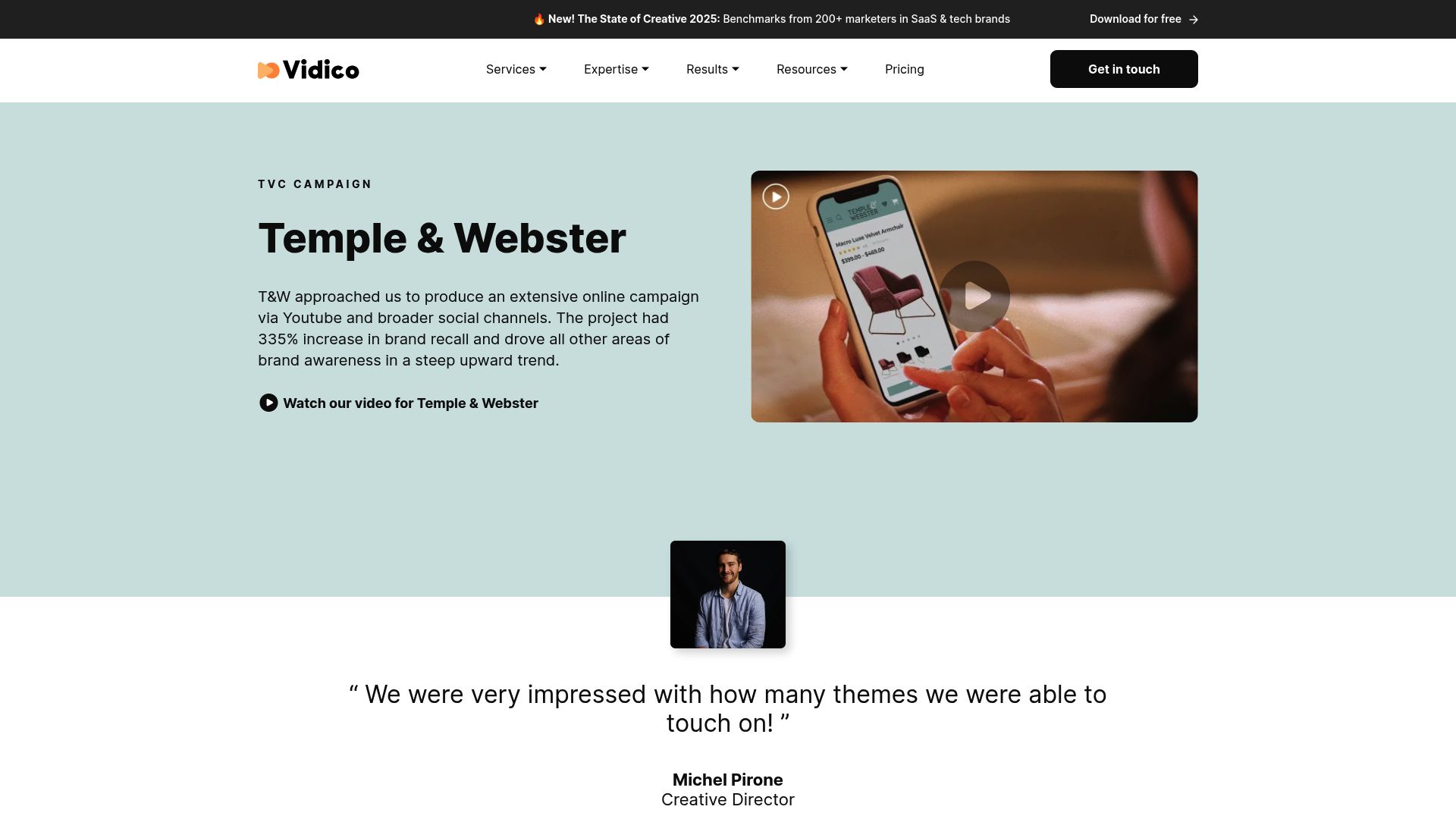
Core features:
- Large-scale video production with cinematic quality
- Seamless integration of home décor products into aspirational living scenes
- Messaging centered on comfort, style, and transformation
Key benefits:
- Achieved a staggering +335% brand recall
- Elevated brand perception among home shoppers
- Sparked conversations and shares across social platforms
Target audience: Home décor and furniture shoppers, including families, singles, and design enthusiasts.
Pros:
- Emotional resonance leaves a lasting impression
- Visually striking, memorable campaign
- Strong brand positioning that extends beyond a single product
Cons:
- Higher production costs
- Less direct product focus in ad creatives
Unique selling point:
This campaign demonstrates the power of storytelling in ecommerce ads, showing how emotional branding can drive both long-term loyalty and sales growth. For brands aiming to elevate perception and recall, Temple & Webster sets a new standard.
Glossier: Relatable UGC-Style Ad
Glossier’s UGC-style ecommerce ads are a masterclass in authenticity. By leaning into real customer testimonials and product demonstrations, Glossier built trust and engagement with its core audience—Gen Z and Millennials.
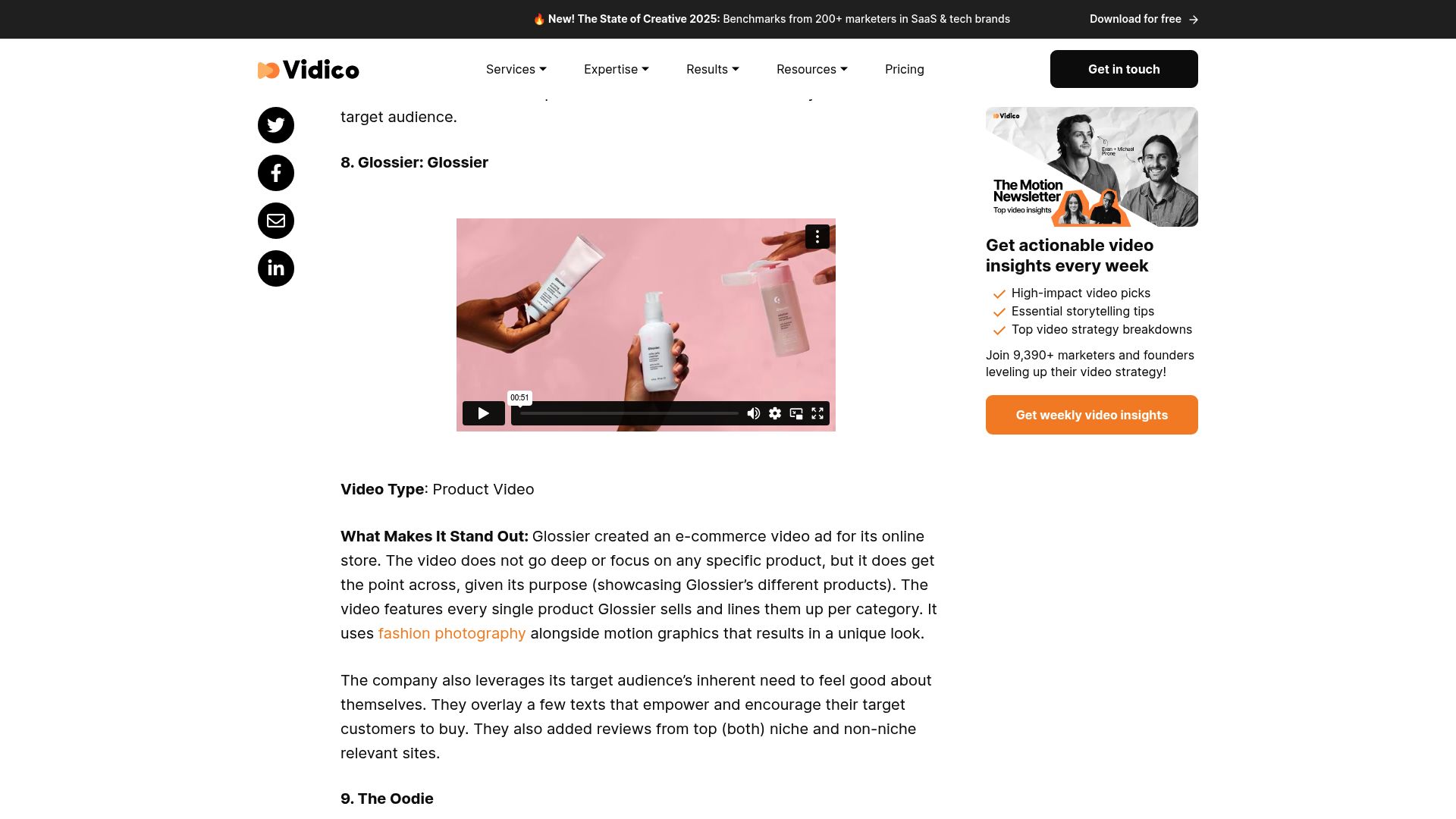
Core features:
- Authentic, user-generated video content
- Micro-influencer collaborations for wide reach
- Natural product demos, unfiltered reactions
Key benefits:
- Boosted engagement rates and social shares
- Increased conversion rates thanks to relatable content
- Built a loyal, vocal community around the brand
Target audience: Gen Z and Millennial beauty lovers seeking genuine recommendations.
Pros:
- Highly relatable and scalable
- Cost-effective compared to polished studio productions
- Easy to adapt for different campaigns
Cons:
- May lack the polish of professional shoots
- Requires active community management
Unique selling point:
Glossier’s approach proves that ecommerce ads don’t need big budgets—just real voices and real experiences. It’s a blueprint for viral, shareable content that converts.
Koala: Humor-Driven Short-Form Video
Koala’s short-form video campaign stands out in the ecommerce ads landscape for its witty, fast-paced humor. The brand focused on product benefits like comfort and convenience, all wrapped in a memorable, lighthearted script.
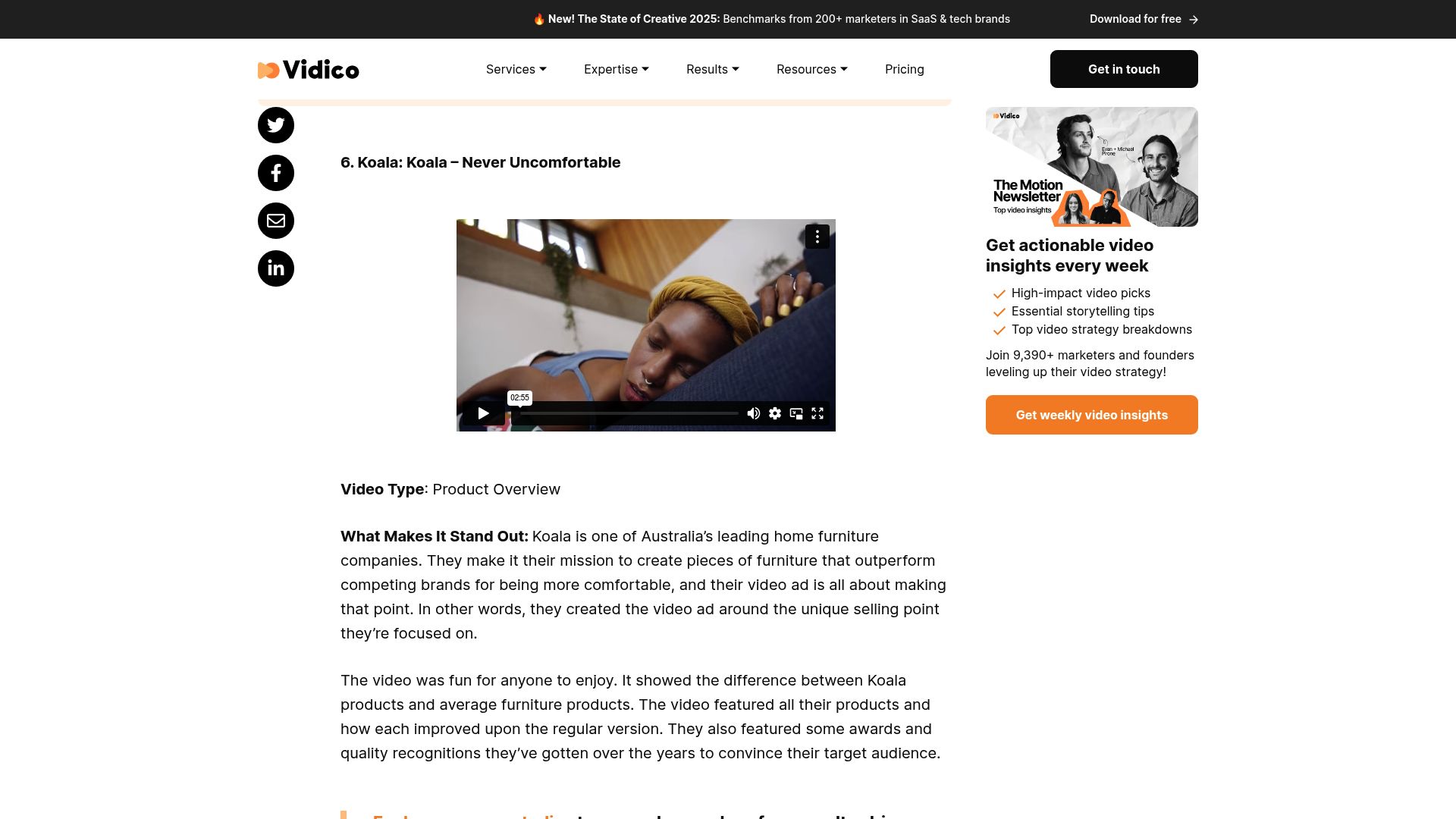
Core features:
- Punchy, under-30-second videos
- Playful tone that appeals to young audiences
- Direct call-to-action inviting viewers to shop
Key benefits:
- Exceptionally high view-through and engagement rates
- Reinforced Koala’s fun, approachable brand personality
- Sparked curiosity in potential buyers
Target audience: Young adults, city dwellers, and online mattress shoppers.
Pros:
- Entertaining and highly shareable
- Strong, clear CTA
- Perfect for mobile-first platforms
Cons:
- Humor can be hit-or-miss depending on the audience
- Short format may limit in-depth messaging
Unique selling point:
Koala showcases how humor and brevity can make ecommerce ads memorable, driving both awareness and conversions in crowded digital spaces.
Juni: Data-Driven Performance Creative
Juni’s campaign exemplifies the future of ecommerce ads with its relentless focus on data and optimization. By running A/B tests on both video and static ad formats, Juni continually refined its message and creative to maximize results.
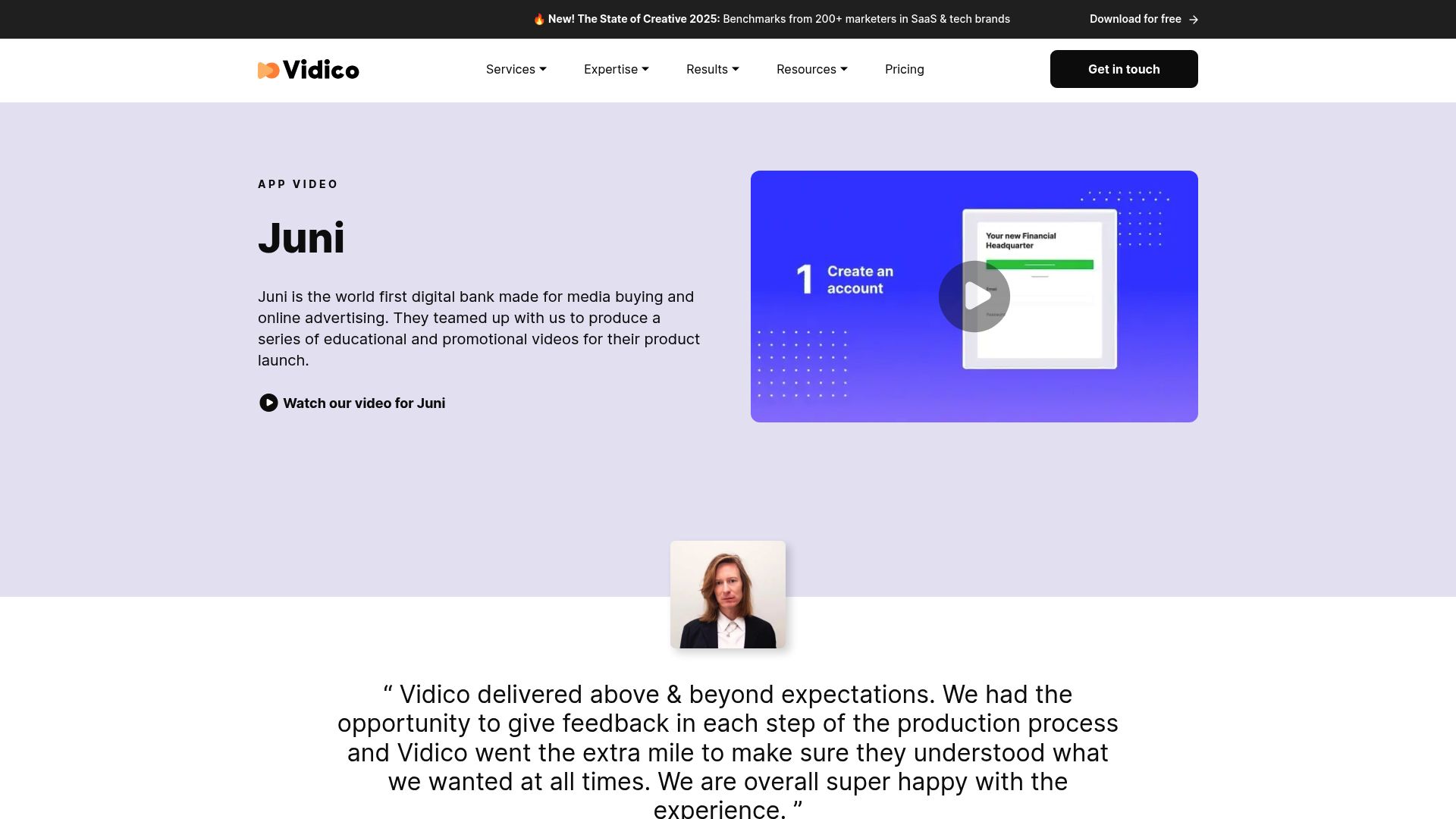
Core features:
- Performance-based creative, tested and iterated
- Use of analytics to guide content tweaks
- Multi-platform rollout for broad reach
Key benefits:
- Outperformed legacy ads by 75%
- Significantly increased return on ad spend (ROAS)
- Drove measurable growth for fintech and ecommerce clients
Target audience: Financial services, fintech startups, and ecommerce entrepreneurs.
Pros:
- Highly adaptable and results-focused
- Scalable across digital platforms
- Encourages a culture of testing and learning
Cons:
- Requires ongoing investment in data analysis
- Creative fatigue if not refreshed regularly
Unique selling point:
Juni’s approach to ecommerce ads proves that continual creative optimization and testing are key to unlocking higher ROI and staying ahead in a competitive market.
Dollar Shave Club: Viral Launch Video
Dollar Shave Club’s iconic launch video remains one of the most legendary ecommerce ads of all time. With a bold, humorous script and direct founder involvement, the ad went viral overnight, reshaping the male grooming industry.
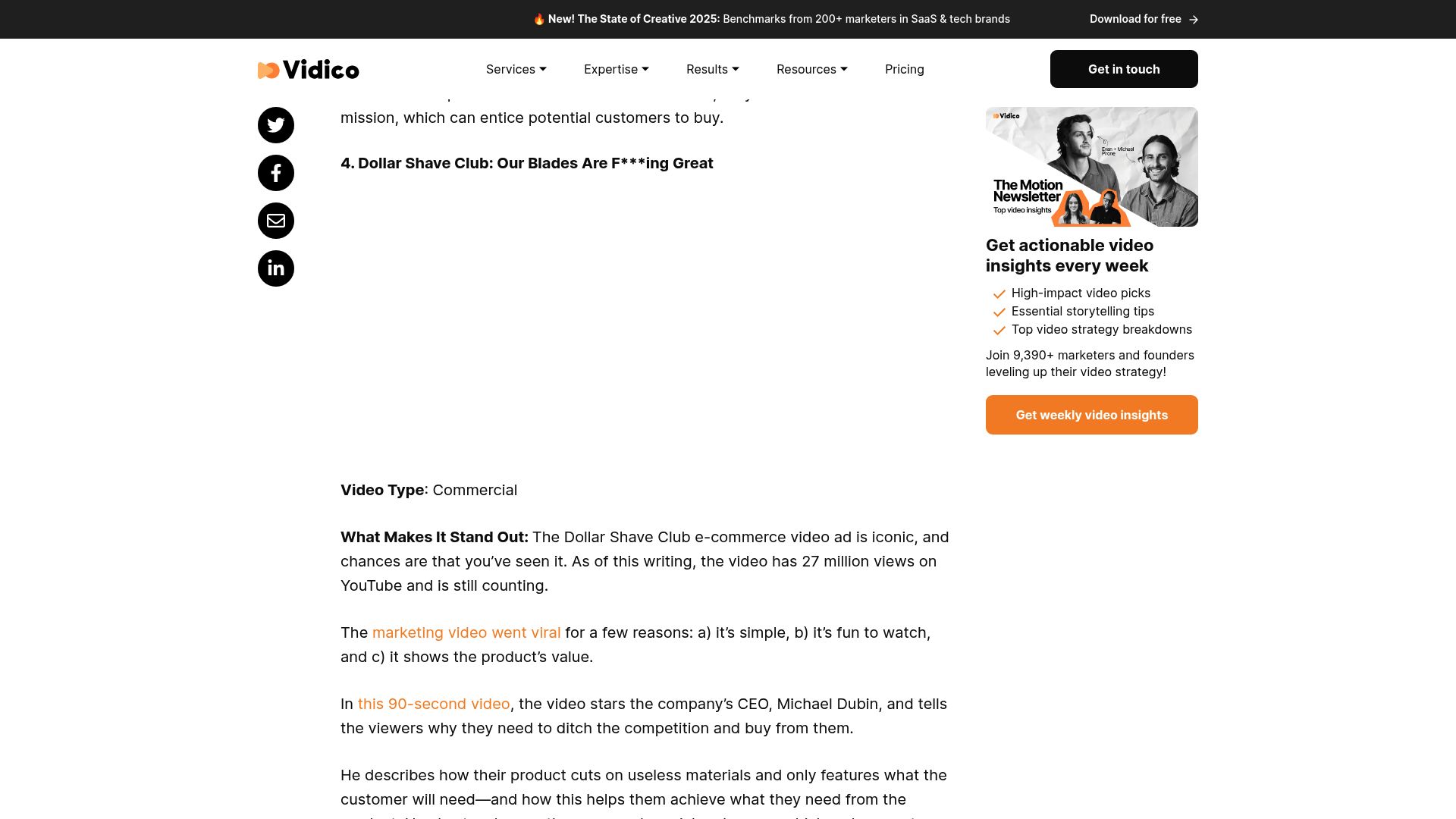
Core features:
- Low-budget, high-impact production
- Candid, comedic storytelling
- Sharp focus on product value and brand mission
Key benefits:
- Massive spike in brand awareness
- Rapid subscriber acquisition
- Disrupted an entire industry with a single video
Target audience: Value-conscious male grooming shoppers.
Pros:
- Memorable and instantly recognizable
- Highly shareable across social platforms
- Cost-efficient for maximum reach
Cons:
- High risk/reward—bold humor might not fit all brands
- Success can be hard to replicate
Unique selling point:
Dollar Shave Club shows how ecommerce ads, when executed with creativity and authenticity, can turn a startup into a household name almost overnight.
Comfort Works: Explainer/Brand Video
Comfort Works’ explainer video is a textbook example of how ecommerce ads can educate and convert. The campaign combined clear product demonstrations with before-and-after visuals, making the value proposition crystal clear.
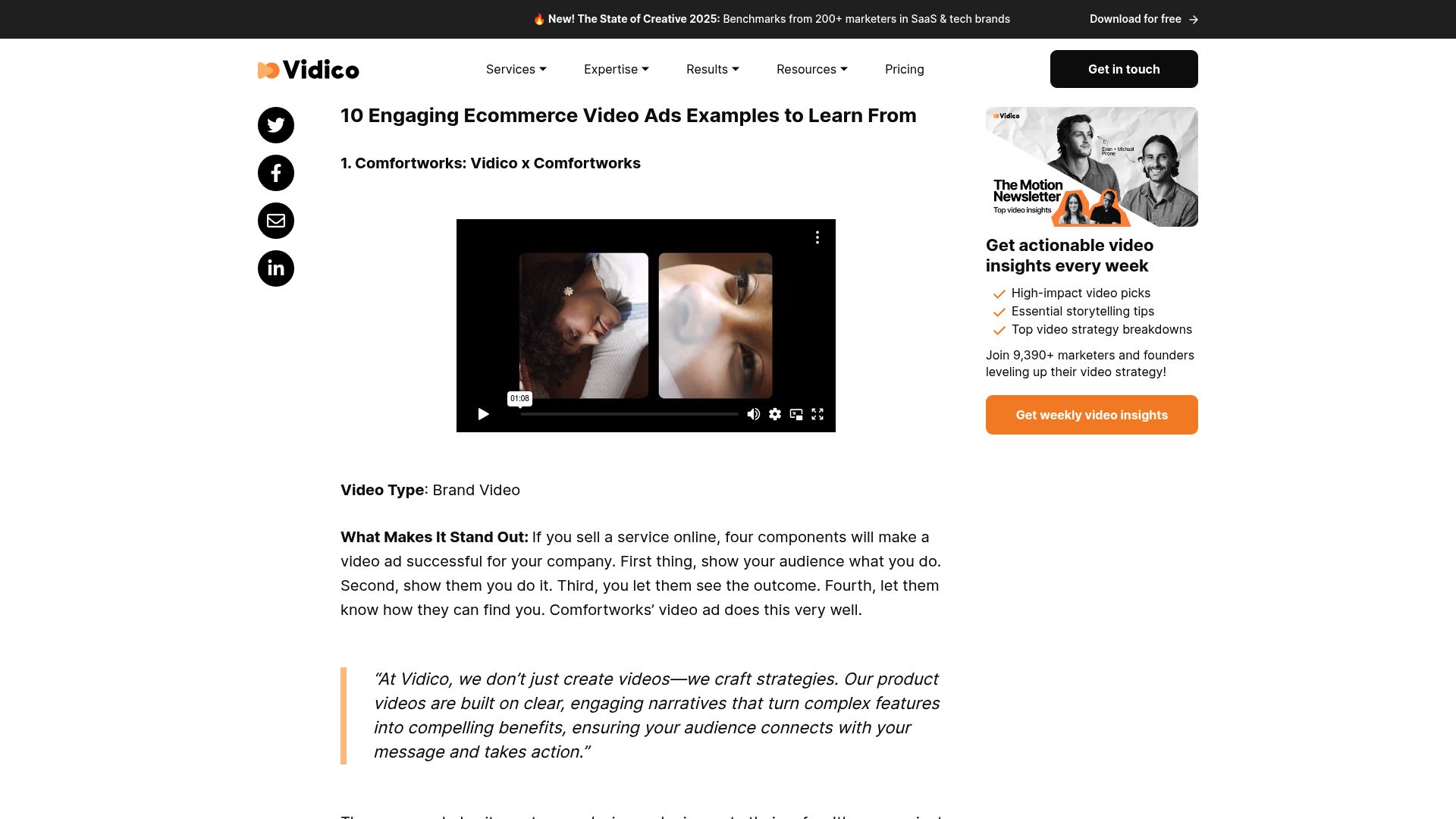
Core features:
- Step-by-step explanations of product use
- High-quality visuals showing transformations
- Strong, direct calls-to-action
Key benefits:
- Built trust and credibility with potential buyers
- Increased direct response rates
- Helped customers visualize product impact
Target audience: Homeowners, interior design fans, and DIY enthusiasts.
Pros:
- Informative and trustworthy
- Visually compelling
- Drives high-intent conversions
Cons:
- Slightly longer format may not engage impatient viewers
- Requires investment in professional production
Unique selling point:
By blending education with inspiration, Comfort Works proves that ecommerce ads can be both beautiful and effective, especially for products requiring explanation.
The Oodie: Social-First Influencer Ad
The Oodie’s social-first influencer campaign is a case study in leveraging viral trends for ecommerce ads success. By partnering with creators on TikTok and Instagram, the brand reached massive audiences and drove rapid sales.
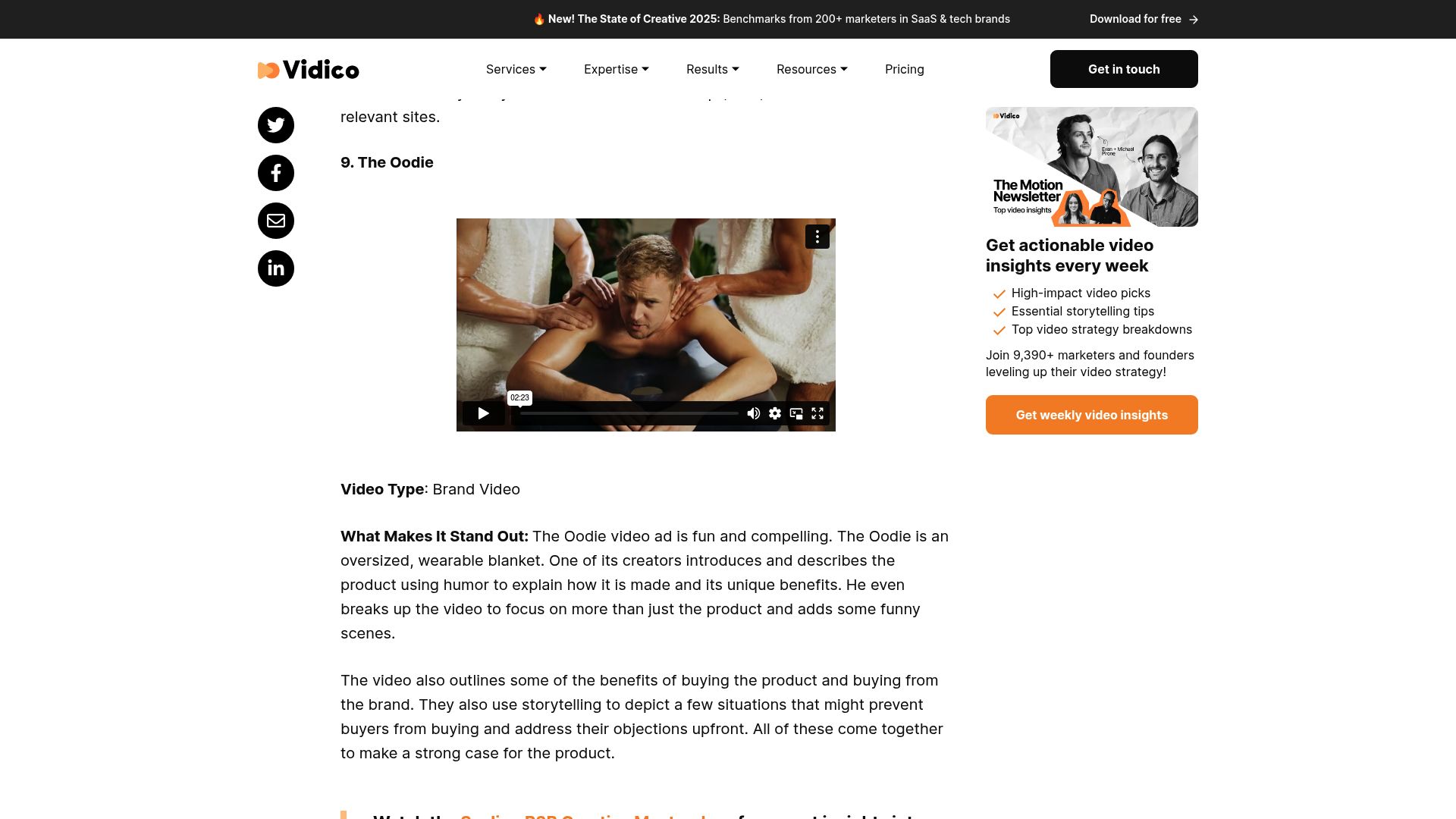
Core features:
- Playful, trend-driven video content
- Authentic influencer testimonials
- Integration of viral challenges and hashtags
Key benefits:
- Explosive reach and engagement
- Fast sales spikes during campaign launches
- Strengthened brand community
Target audience: Teens, young adults, and anyone seeking cozy loungewear.
Pros:
- Highly adaptable to new trends and platforms
- Drives word-of-mouth and organic sharing
- Builds a loyal online following
Cons:
- Relies heavily on influencer authenticity
- Short shelf-life for trend-based content
Unique selling point:
The Oodie’s ecommerce ads highlight the power of influencer marketing and viral social challenges to create buzz, drive conversions, and build community—all at scale.
Bambee: Product Explainer with Clear Value Proposition
Bambee’s product explainer video is a shining example of clarity in ecommerce ads. Using animated visuals and a strong value proposition, the campaign communicated benefits in a way that resonated with small business owners.
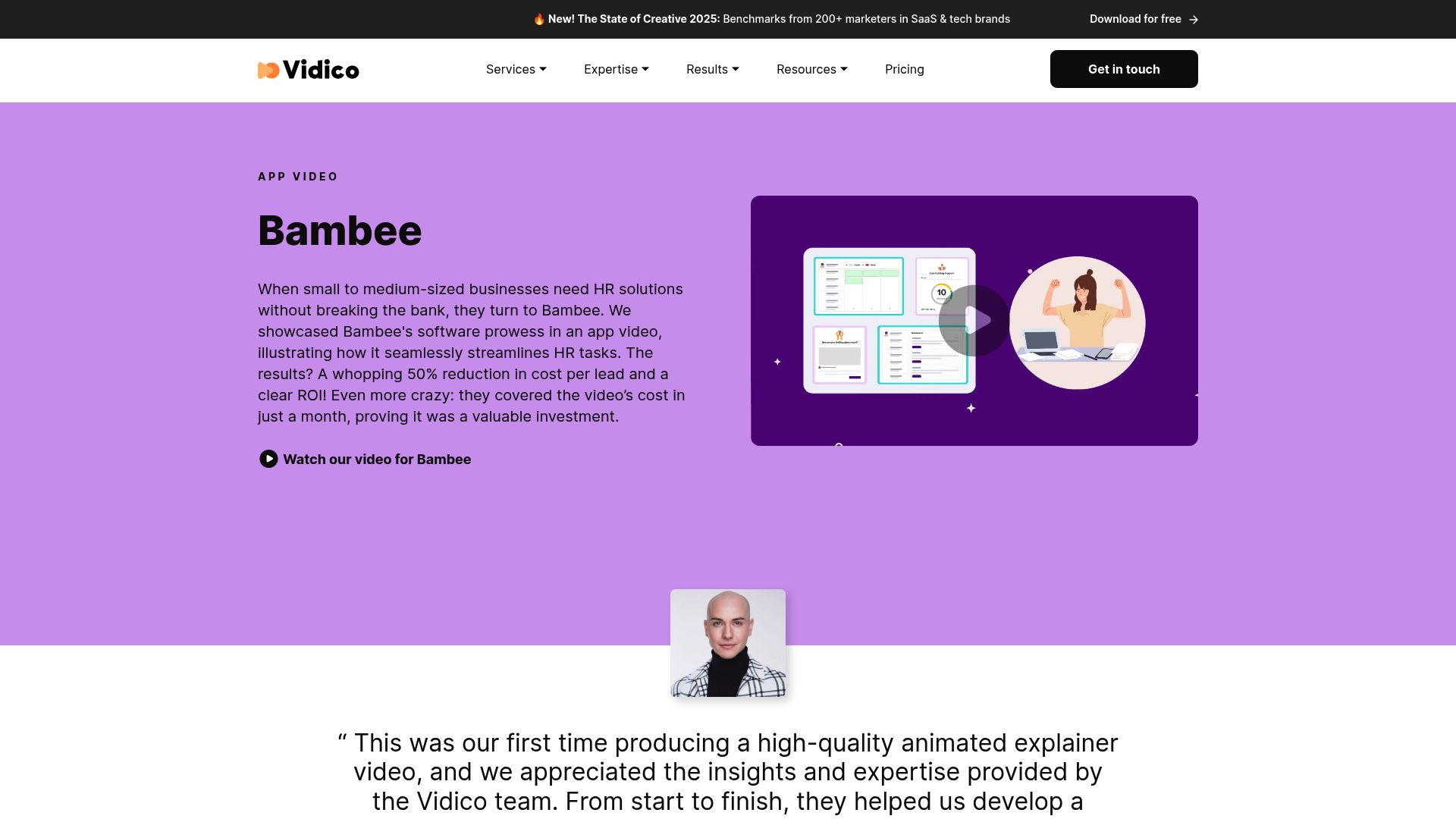
Core features:
- Animated explainers that break down complex services
- Concise messaging focused on ROI and trust
- Direct, compelling calls to action
Key benefits:
- Reduced cost per lead by 50%
- Paid back campaign costs in just one month
- Increased user trust and conversion rates
Target audience: Small business owners, HR managers, and compliance-minded buyers.
Pros:
- Highly educational and focused on value
- Builds credibility with skeptical audiences
- Clear pathway from ad to action
Cons:
- May not appeal to viewers seeking entertainment
- Requires skilled production and scripting
Unique selling point:
Bambee proves that ecommerce ads with clear, value-driven messaging can dramatically lower acquisition costs and drive results—even in complex B2B verticals.
Key Elements of High-Converting Ecommerce Ads in 2025
In 2025, high-performing ecommerce ads are more than just eye-catching—they blend emotion, authenticity, and cutting-edge technology to drive conversions. Brands that master these elements consistently rise above the noise and capture lasting customer attention.
The Power of Storytelling and Relatability
Storytelling sits at the heart of the most successful ecommerce ads. Instead of listing features, top brands weave narratives that create emotional connections. Why does this matter? Because stories stick—customers remember how an ad made them feel long after the details fade.
Authenticity further amplifies this effect. User-generated content, testimonials, and influencer partnerships make ecommerce ads feel genuine and relatable. When viewers see real people sharing honest experiences, trust builds naturally.
Consider Glossier's UGC-style ads. Their approach uses customer testimonials and everyday scenarios, making the brand approachable and aspirational at the same time. Koala, on the other hand, injects humor and wit, transforming a simple mattress pitch into an unforgettable moment. These examples show that relatability and emotion are the secret sauce for memorable, high-performing ecommerce ads.
Visual-First Design and Format Trends
Visuals grab attention in an instant, making visual-first design essential for ecommerce ads in 2025. High-quality images and videos outperform text-heavy ads because they communicate benefits quickly and powerfully.
Short-form video is leading the pack, especially for mobile audiences. Data shows that 15–30 second ads generate higher engagement and completion rates compared to long-form content. Here's a quick comparison:
| Format | Engagement Rate | Best Use Case |
|---|---|---|
| Short-form (15–30s) | High | Social, mobile, UGC |
| Long-form (60s+) | Moderate | Demos, explainers |
Koala's quick, punchy videos and Glossier's bite-sized testimonials thrive because they align with how consumers scroll and interact today. Ecommerce ads that prioritize visuals and brevity consistently outperform those that don't.
Personalization, Interactivity, and CTAs
Personalization is now table stakes for ecommerce ads. Dynamic creative adapts messaging and visuals to each audience segment, boosting relevance and conversion rates. Brands leveraging advanced data insights—like those found in advanced market basket analysis strategies—can deliver hyper-targeted ads that feel tailor-made.
Interactivity is another game-changer. Polls, quizzes, and shoppable videos invite audiences to participate, not just watch. This two-way engagement increases both dwell time and intent to purchase.
Finally, a clear call-to-action is non-negotiable. The best ecommerce ads guide viewers toward a next step with direct, compelling, and mobile-optimized CTAs. Glossier and Koala both excel here, making it easy for customers to act in the moment.
How to Adapt These Winning Ad Strategies for Your Brand
Standing out with ecommerce ads in 2025 means moving beyond guesswork and adopting strategies proven by top brands. Ready to transform your approach? Here’s how to adapt these tactics for your brand—no matter your niche or budget.
Step 1: Audit and Analyze Your Current Ads
Begin with a thorough audit of your ecommerce ads. Look for gaps in storytelling, visual quality, and the clarity of your calls to action. Are your ads emotionally engaging, or do they just list features? Check if your content feels authentic and relatable—elements that drive higher engagement.
Identify which formats have delivered results. Are video or carousel ads outperforming static images? Take inspiration from the winning examples: Juni’s iterative creative tests and The Oodie’s viral influencer content both started with a sharp analysis of what already works.
Step 2: Leverage Data and Test Creative Formats
Next, use customer data to guide your ad messaging and product pairings. Understanding purchase patterns and audience segments allows you to personalize creative for higher impact. For a deeper dive, see Understanding the role of sales data.
A/B test multiple ad formats—short-form video, UGC, and carousels—to discover what resonates. Track metrics like ROAS and conversion rates to compare performance. Brands like Juni show how data-driven optimization can elevate ecommerce ads and boost ROI.
Step 3: Collaborate and Optimize with Influencers and AI
Don’t overlook the power of influencer partnerships. Collaborate with micro-influencers in your niche for authentic reach and relatable content. The Oodie’s TikTok success is a masterclass in trend-driven, social-first ecommerce ads.
Invest in AI tools for creative optimization. Use automated insights to refine visuals, messaging, and targeting. This approach helps you scale successful strategies quickly and adapt to changing trends without missing a beat.
Step 4: Measure, Iterate, and Scale
Consistency is key. Repurpose your best-performing ecommerce ads across channels for maximum reach. Monitor key metrics—CTR, ROAS, and conversion rates—and be ready to adapt as you learn.
Brands like Juni and The Oodie thrive by continually evolving their ad strategies, testing new formats, and embracing feedback. Your path to high-converting ecommerce ads is an ongoing process—refine, experiment, and scale what works.
Future Trends in Ecommerce Advertising
The landscape for ecommerce ads is evolving at breakneck speed. Brands that want to stay ahead in 2025 need to anticipate what’s next—not just react to the competition. So, what trends will define the future of ecommerce ads and separate the leaders from the laggards?
Artificial intelligence is at the heart of tomorrow’s ecommerce ads. Predictive targeting, automated creative generation, and campaign management are becoming the norm. AI shopping agents are already transforming the way consumers interact with ecommerce ads, personalizing experiences and streamlining purchases. Shoppable content is also on the rise, blurring the lines between browsing and buying. Augmented reality and interactive formats—like virtual try-ons and immersive demos—are quickly moving from novelty to necessity.
Sustainability and social impact messaging are gaining traction, especially with Gen Z and Millennials. Consumers expect ecommerce ads to reflect their values, not just push products. Privacy-first advertising is also front and center, as brands navigate stricter data regulations and the decline of third-party cookies. Community-driven campaigns, tapping into micro-influencers and brand advocates, are helping brands foster loyalty and organic reach.
Staying relevant means embracing a continuous creative refresh. The pace of change in ecommerce ads is relentless, and brands must iterate quickly to keep up. Video ad spend is projected to surge, while AR adoption continues its upward trend. For a deeper dive into the numbers shaping these trends, check out the latest Global Ecommerce Market Trends and Statistics. As consumer expectations rise, only the most innovative ecommerce ads will break through the noise and drive real results.